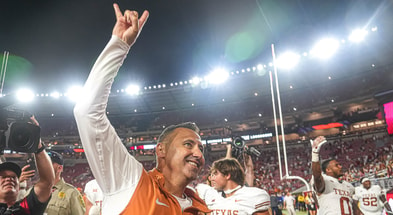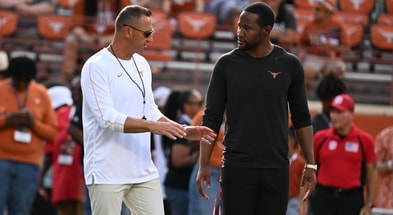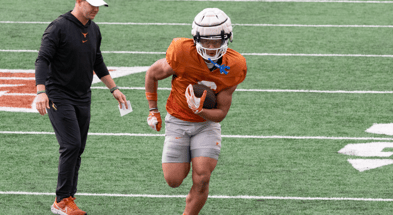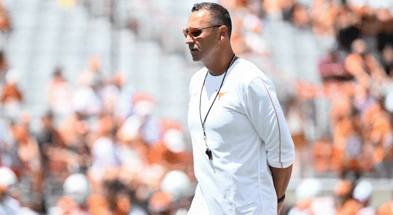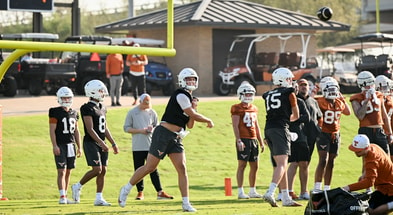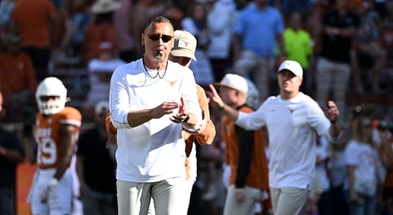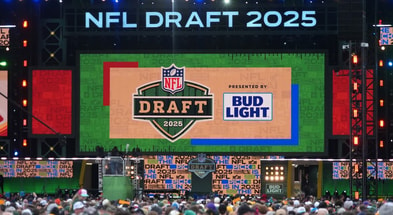Is Oklahoma A Top 10 Football Job Anymore?

Nope. And it happened rather quickly.
[Join Inside Texas TODAY and get FOUR MONTHS for just ONE DOLLAR!]
I don’t hold this opinion based on their recent run of adversity under Brent Venables. OU’s current state on the field is as reflective of Lincoln Riley ambushing them like a brisket with a kiln as Venables’ deficiencies. Throw it out if you like.
I’m not prisoner-of-the-moment guy, though I live in a larger society that prefers to spend most of its time in solitary confinement.
I’m writing about now and the future.
Nor am I poking at a rival. I possess a God-given right to do that, but that’s not the purpose of this piece.
The structural changes in college football are creating level shifts. It’s interesting to see who that advantages and who it handicaps.
The NFL-ization of the college game has had some interesting knock on effects, some predictable, some less anticipated.
Who knew that Notre Dame’s revival would be predicated on legally paying players and lowered academic standards behind a charismatic coach? Not Brian Kelly. And he had a pretty good bird’s eye view in South Bend for a dozen years.
Last year’s bravura 7-6 performance by Nebraska was its first winning record in seven years. The Huskers have now lost 4+ games for 21 consecutive years. Tradition and past achievements don’t guarantee future success.
The Miami Hurricanes won 5 national titles between 1983 and 2001, appeared in several more of those games, and were the dominant team of their era. They’ve not exactly dominated the zeitgeist over the last two decades.
Life comes at you fast. But in the moment, it can be hard to detect.
So the premise is simple. It cuts through all of the bullshit.
If every college football job in America were thrown open tomorrow, what’s the program draft order for those who understand the current relevant factors?
There would be a lot of debates about the order of the top dozen programs, but probably not a lot of debate about the programs in the discussion. The order is a fairly meaningless debate – you simply need to be in that tier. National title hopes are differentiated by your coach, upper class NFL talent, and your QB, not whether you’re Desirable Program #3 or #7.
But you’d like to be in that upper dozen.
Oklahoma would have been just a minute ago. They’re not now.
Let’s talk about why, discussing the relevant factors…
Single-Minded Focus
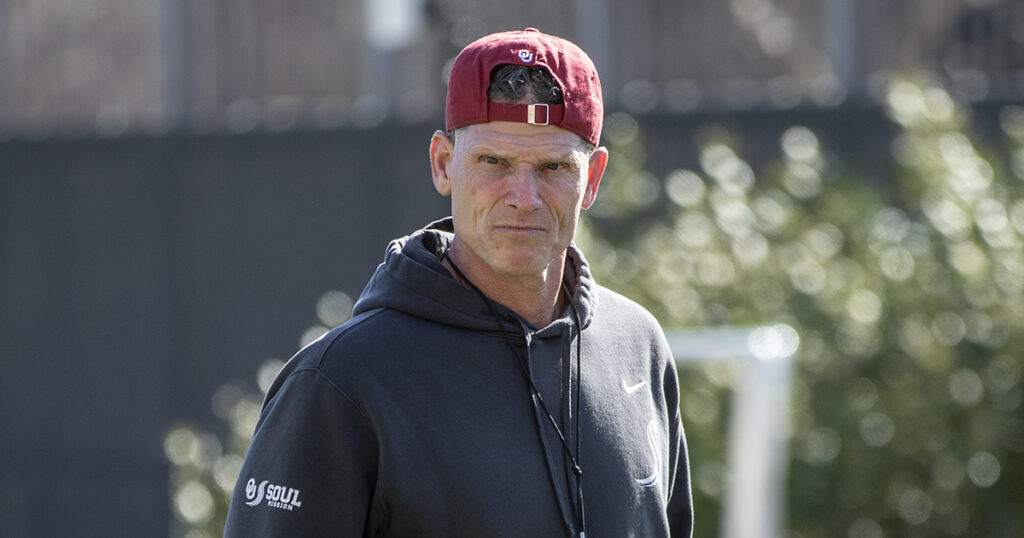
With no will to win, you won’t.
Does your school prioritize football? Game day environment, facilities, culture, administrative emphasis and so on. So-called t-shirt fans and national interest matter, despite whatever the Aggies tell you.
Oklahoma scores quite well here. I’d struggle to find a school where football means more or provides a more fundamental part of the state identity. The old saw that Oklahoma demands a school that the football team can be proud of comes to mind.
That’s tied to a larger culture that’s been fairly proficient at disappearing player problems with law enforcement, grades, or university admins. A useful sell and retention mechanism that broadens the pool of edgy dudes who are good at football.
Tradition/History
Oklahoma is elite. 6th all time in wins and program winning percentage, seven national titles, a few pioneering controversial/charismatic coaches that created aura, and a recognizable brand. That history isn’t exactly too distant in the rear view – from 2000 to 2021, Oklahoma won 228 football games and they dominated the Big 12 conference.
Tradition and history have appeal, but it must be understood properly. It’s salient when it fuels passion, interest, alumni giving and gets great teams on the field today and tomorrow, but it’s irrelevant navel-gazing when it doesn’t.
NIL
If that acronym had been in this essay a few years ago, it would have drawn quizzical looks. “You mean the Ed O’Bannon lawsuits?” What are you babbling about?”
Now even the casual fan understands its primacy.
There are a lot of ways to skin the NIL cat.
A single very rich dude who can use it as a marketing tool (Oregon).
The mass mobilization of the upper middle class (Auburn, Alabama, Penn State).
Rich dudes and the upper middle class (Texas, Texas A&M, Ohio State, Notre Dame, Florida).
Ignoring it, then freaking out (Clemson).
Embezzling from children’s hospitals (LSU).
Circumventing RICO statutes (Miami).
Oklahoma does fine in NIL, though they’re fishing in a shallower pond. On a per capita basis, they get after it, but NIL doesn’t reward per capita. It rewards volume.
However, they do have an athletic department far more likely to grasp why raising football NIL is more important than the 3rd refurbish of the women’s soccer locker room. More wood behind the arrow, but not as many arrows to fire.
The relevant issue here is not total NIL but the erosion of a competitive advantage.
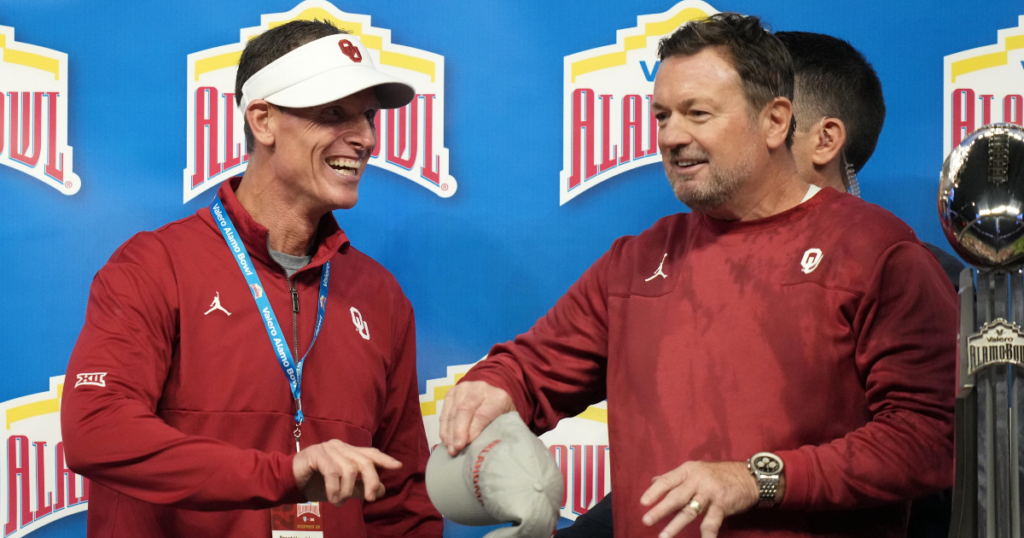
Paying players through various means was a differentiating tool for OU football. They weren’t alone in that and it’s not “the only reason they were good” – let’s keep the simpleton takes out of here – but if you don’t understand it as a historical part of OU football’s value prop, you’re deluded.
They’ve always been comfortable in the grey zone, and shrugged about that fact viewed against the larger hypocrisies of the sport.
This isn’t a moral judgement – NCAA bylaws can’t be found on Moses’ tablets – but it was a useful competitive advantage for a program that could also sell football first culture, winning teams, and a campus life built around its star athletes.
It’s not that Oklahoma dramatically lags NIL per se, it’s that putting payments above board eroded a real differentiating value proposition.
Conference Realignment
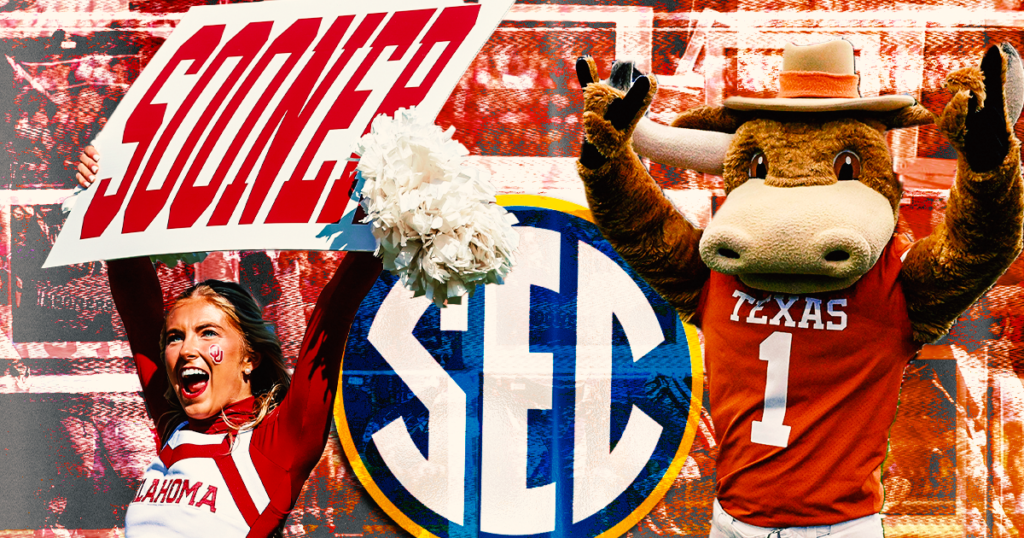
Like Texas, Oklahoma had to go to the SEC to remain relevant. A big fish in a much larger pond.
For most of its history, Oklahoma profited from being a shark amongst guppies. That reinforced their powerful self-image as inevitable winners.
The Big 8 was a non-competitive farce in most years. It reduced OU’s regular season schedule to matchups with Texas and Nebraska.
Top 10
- 1New
Johntay Cook
Headed to ACC
- 2Hot
Fan who fell from stands
20-year old former CFB player
- 3Trending
Donald Trump
Wants Saban back as Alabama HC
- 4
Kentucky, St. John's
Set to play in 2025-26
- 5
Bracketology
Way Too Early Tournament projection
Get the On3 Top 10 to your inbox every morning
By clicking "Subscribe to Newsletter", I agree to On3's Privacy Notice, Terms, and use of my personal information described therein.
The Big 12 was more competitive, until it wasn’t.
From Bud Wilkinson to Riley, those leagues allowed Oklahoma to rack up wins behind high level coaching, clear identity, talent advantages, and a slickly run organization.
Give credit where its due, but take note of what happened to Oklahoma more often than not when asked to scale up in the playoffs or in a title game against a national elite outside of their preferred ecosystem (USC, Georgia, Clemson, Alabama, Miami, LSU).
The SEC offers Oklahoma a future and a chance, but it also demands a level up. They will have to find a different path to excel at historical levels; their past holds few answers.
Recruiting Base
NIL and national television make recruiting more national in scope, but proximity still matters. Oklahoma has long fed off of state of Texas recruits, but it has always recruited well nationally, often feasting in places like California when their regional powers were negligent.
This is not a choice, but an imperative. The state of Oklahoma boasts modest talent within its state borders. The 2026 On3 recruiting rankings show five 4-star recruits in their state. In some years, I’ve seen as few as three.
Schools like Florida, LSU, Georgia, USC (when they care) simply have a leg up here. They have both a regional base and a national outlook.
Oklahoma finds itself much more in the category of schools like Tennessee and Oregon. They have to get their groceries down the highway, not down the street.
The Sooners liked it much better when most powerhouse programs were regional or parochial in outlook.
Adaptation
Oklahoma has always been highly adaptable, often near the forefront of innovation.
They didn’t invent the wishbone, but followed fast and made it better. They didn’t integrate before UCLA’s teams in the 1930s, but their 1956 is better than Alabama’s 1971. They didn’t invent the spread, but hired an autist OC to run it when most coaches still thought it was a gimmick for lesser programs.
Now more than ever, Oklahoma must innovate to win. What’s their latest innovation?
The recent hire of Jim Nagy to act as their General Manager – a man who reports directly to AD Joe Castiglione and special advisor Randall Stevenson, former chair of AT&T, is either an example of Sooner innovation, a no-confidence vote for Venables, or a potential crippling of their ability to hire their next college coach.
Maybe all three.
There are a lot of reasons that being the head coach in the NFL game is now preferable over being a college head man, but the college coach having absolute control of his program is still the best argument for coaching on Saturday.
Oklahoma’s current structure tells future coaches that they won’t have that power. Hiring an elite coach is the only path to Oklahoma getting back its mojo. Are elite coaches more likely to want to be above their GM on the org chart?
Simple question for OU fans: would a 40 year old Bob Stoops consent to this current structure?
Good Enough Will Do
So is OU doomed to a future of 6-6 seasons, fraught with newfound administrative inefficiencies, no natural recruiting base, and a fading set of differentiating mechanisms, certain to become the next Nebraska?
One can hope!
I don’t think so.
Good enough is still the qualifier. Oklahoma didn’t fall from a Top 10 job to Top 35. But they do find themselves in a new league where they are no longer its bully, but at best, the 6th best program. They need to rethink some things because there are a lot of other kids who can kick their ass near the bike rack now.
These distinctions aren’t chasms though.
An efficiently run OU with a great coach will have a better football team on the field than Florida or LSU with a mediocre coach riddled with administrative buffoonery.
[Order THE LONGHORN ALPHABET today and teach your little ones the A to Z’s of Texas Football!]
Oklahoma meets the main qualifier of future success – an administrative and cultural will to win – but their once healthy margins of competitive advantage are now vanishingly small in the new world of college football.


